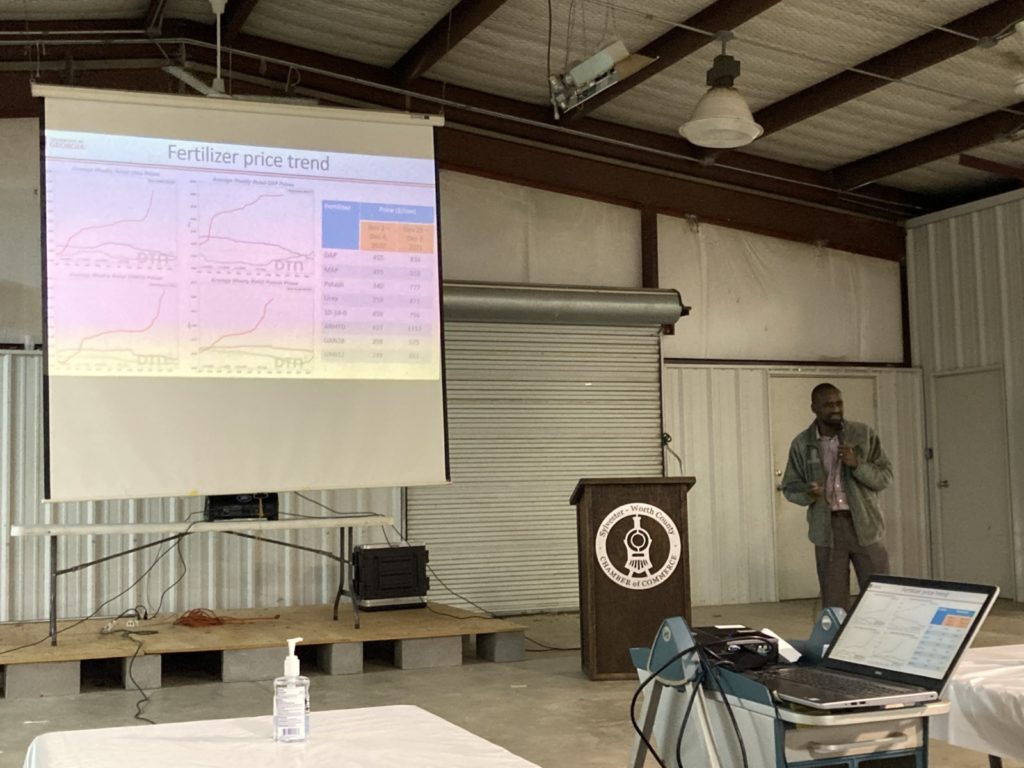Last week we had our Worth County Extension Corn/Soybean/Wheat Production meeting. Dr. Henry Sintim gave an update on Corn Fertility and Mr. Rome Ethredge shared timely information on Corn, Soybean, and Wheat production.


Georgia Grain News – 2/21/22 (Rome Ethredge)
Corn Planting
Folks are getting planters ready and making sure everything is in working order. Here’s some good planting info, mostly from the UGA Corn production guide.
Do not underestimate the importance of good plant stands. Improper establishment will have a negative impact on yield as corn can be sensitive to planting depth, thick or thin populations, highly variable spacing, and delayed emergence. Inspect and service your planter and replace worn parts. Utilize the expertise that planter companies have to gain insights on properly adjusting all parts to changing soil and weather conditions as to optimize the operation.
Ensure that coulters and disc openers are aligned accurately and the planter is level when you begin planting. Calibrate the planter for a proper seed drop. Make sure seed is between 1.5 and 2 inches deep. Avoid too much down pressure especially when wet but make sure the furrow is closed properly. Check your speed to ensure that seed spacing is correct so as to avoid differences in plant emergence. Speed can increase your stand spacing so optimize your planting speed according to your seed density and the ability to reduce the spacing differences at seed drop.
Avoid planting when soil temperatures drop below 55 F. Variable plant emergence can reduce yields as much as 10 to 20% depending on the establishment delay of neighboring plants. Delayed plants cannot compete with older, better established plants. A field where all plants emerge within 12 to 24 hours of the first emerging plant is considered a successful stand that may provide a high yield potential for you to manage.
Plant corn as soon as temperature and moisture become favorable for seed germination and seedling growth. Soil temperature in the seed zone should be 55°F or greater before planting. Corn seed will sprout slowly at 55°F while germination is prompt at 60°F. One should delay planting if cold weather drops soil temperatures below 55°F at the two-inch soil level. It is generally safe to plant if soil temperatures are 55°F and higher, and warm temperatures are in the forecast.
Extremely early planting introduces a risk to frost or freeze damage and subsequent loss of stands. Usually, as long as the growing point is below ground level, corn can withstand a severe frost or freezing damage without yield reduction. It is best therefore to monitor soil conditions and weather if your desire is to plant as early as possible. Generally, it takes corn seed 7 to 12 days to emerge when planted in soils at 55°F.
Early-planted corn typically out-yields late-planted corn. Depending on your location, planting dates may range from early March in south-Georgia to mid-May in north Georgia. Early planting helps avoid periods of low rainfall and excessive heat during pollination, both of which lead to internal water stress during critical periods of corn development. Avoid planting when big rains or hard cold are in the 3 day forecast. We don’t want to plant when too wet as we’ll get side wall compaction and other problems that aren’t good.
A great resource that is available for up-to-date weather information is the University of Georgia Weather Network (https://www.georgiaweather.net). Weather station data is collected at each of the locations. Regarding the information above, soil temperatures at the 2-inch depth can also be accessed to assist in making corn planting decisions. If you have further questions about this, please contact your local Extension Office.